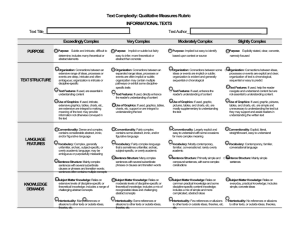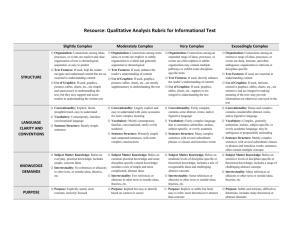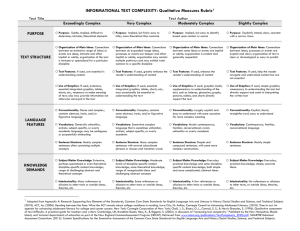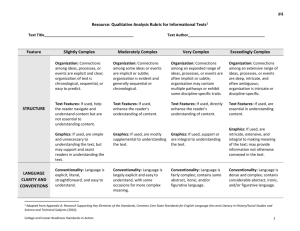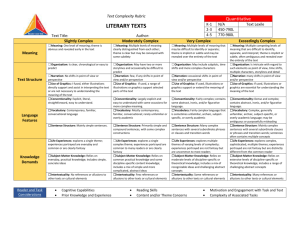informational text complexity
advertisement
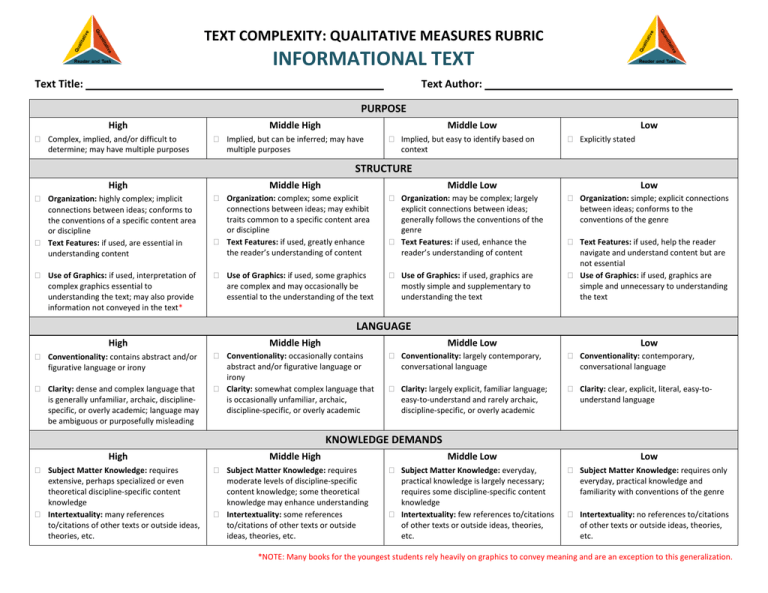
TEXT COMPLEXITY: QUALITATIVE MEASURES RUBRIC INFORMATIONAL TEXT Text Title: Text Author: PURPOSE High Middle High Complex, implied, and/or difficult to determine; may have multiple purposes Implied, but can be inferred; may have multiple purposes Middle Low Implied, but easy to identify based on context Low Explicitly stated STRUCTURE High Middle High Middle Low Organization: highly complex; implicit connections between ideas; conforms to the conventions of a specific content area or discipline Text Features: if used, are essential in understanding content Organization: complex; some explicit connections between ideas; may exhibit traits common to a specific content area or discipline Text Features: if used, greatly enhance the reader’s understanding of content Organization: may be complex; largely explicit connections between ideas; generally follows the conventions of the genre Text Features: if used, enhance the reader’s understanding of content Use of Graphics: if used, interpretation of complex graphics essential to understanding the text; may also provide information not conveyed in the text* Use of Graphics: if used, some graphics are complex and may occasionally be essential to the understanding of the text Use of Graphics: if used, graphics are mostly simple and supplementary to understanding the text Low Organization: simple; explicit connections between ideas; conforms to the conventions of the genre Text Features: if used, help the reader navigate and understand content but are not essential Use of Graphics: if used, graphics are simple and unnecessary to understanding the text LANGUAGE High Conventionality: contains abstract and/or figurative language or irony Clarity: dense and complex language that is generally unfamiliar, archaic, disciplinespecific, or overly academic; language may be ambiguous or purposefully misleading Middle High Middle Low Conventionality: occasionally contains abstract and/or figurative language or irony Clarity: somewhat complex language that is occasionally unfamiliar, archaic, discipline-specific, or overly academic Low Conventionality: largely contemporary, conversational language Conventionality: contemporary, conversational language Clarity: largely explicit, familiar language; easy-to-understand and rarely archaic, discipline-specific, or overly academic Clarity: clear, explicit, literal, easy-tounderstand language KNOWLEDGE DEMANDS High Subject Matter Knowledge: requires extensive, perhaps specialized or even theoretical discipline-specific content knowledge Intertextuality: many references to/citations of other texts or outside ideas, theories, etc. Middle High Subject Matter Knowledge: requires moderate levels of discipline-specific content knowledge; some theoretical knowledge may enhance understanding Intertextuality: some references to/citations of other texts or outside ideas, theories, etc. Middle Low Subject Matter Knowledge: everyday, practical knowledge is largely necessary; requires some discipline-specific content knowledge Intertextuality: few references to/citations of other texts or outside ideas, theories, etc. Low Subject Matter Knowledge: requires only everyday, practical knowledge and familiarity with conventions of the genre Intertextuality: no references to/citations of other texts or outside ideas, theories, etc. *NOTE: Many books for the youngest students rely heavily on graphics to convey meaning and are an exception to this generalization.
